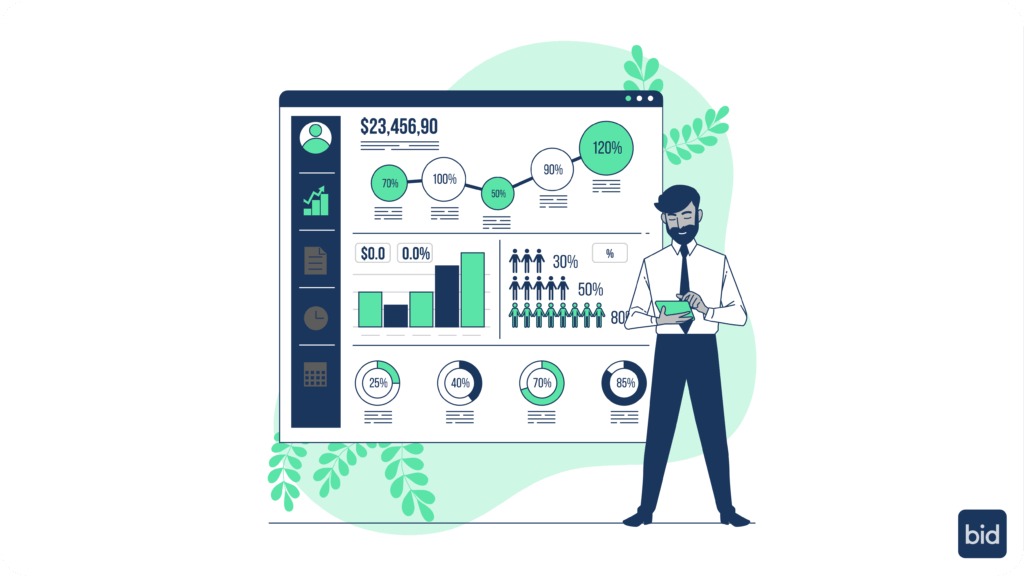
Q4 is the most competitive advertising period of the year. Ad fatigue accelerates, CPMs spike, and players are bombarded with holiday promotions from every direction. For iGaming apps—whether sports betting, casino, poker, or daily fantasy—the creative challenge is real: how do you break through the noise when everyone is running “holiday bonus” campaigns?
The answer isn’t just spending more. It’s about using creative formats, messaging, and optimization strategies that actually drive conversions. Generic festive imagery won’t cut it. A snowflake-covered banner with “Happy Holidays” gets scrolled past in milliseconds. But a 15-second video showing a real jackpot win with a clear “$100 Bonus—Claim Now” CTA? That stops thumbs.
With higher competition in Q4, your creative becomes the differentiator between a scroll and a click, between a wasted impression and a first-time deposit. This guide breaks down which creative formats perform best for iGaming apps during the holidays, what elements actually drive conversions, and how to optimize constantly without burning out your team.

The Q4 Ad Fatigue Challenge in iGaming
Holiday ad fatigue is brutal. Users see three to five times more ads in Q4 than any other quarter. Retailers are pushing Black Friday deals, entertainment apps are promoting holiday content, and every iGaming competitor is running bonus campaigns. Attention spans shrink, scroll speeds increase, and the “holiday bonus” message becomes white noise.
For iGaming marketers, this creates a high-stakes problem. Higher CPMs mean every wasted impression hurts more. Generic creative leads to lower click-through rates, which drives up cost per install and cost per deposit. Meanwhile, competitors with better creative win auctions at lower bids because their engagement rates are stronger.
What’s at stake? Q4 often represents 30-40% of annual iGaming revenue. Sports betting peaks during NFL playoffs and bowl games. Casino apps see deposit spikes around New Year’s. Poker platforms run holiday tournament series. Missing the creative mark during this window means missed revenue that won’t come back.
The solution is data-driven creative optimization. Test constantly, retire underperformers fast, and use formats proven to engage—not just what “feels” festive. Personalize creative by vertical, user segment, and event. That’s how you cut through the noise and actually convert.

Mobile Gaming App Creative Formats That Actually Perform in Q4
Not all ad formats are created equal. Some drive engagement and conversions, while others drain budget without results. Here’s what works for iGaming apps during the holidays.
Video is the highest-performing format for iGaming apps in Q4. It showcases real gameplay, big wins, and excitement in a way static ads can’t match. Video engagement rates consistently outperform display, and the ability to tell a story—even in 15 seconds—makes it ideal for capturing attention.
Best practices for iGaming video ads start with length. Keep it short—15 seconds or less. Mobile users scroll fast, and anything longer risks drop-off. Hook viewers in the first two seconds by showing a big win, jackpot alert, or live game action immediately. Don’t waste time with slow intros or branding—lead with the excitement.
Make your video sound-off friendly. Eighty-five percent of mobile video is watched without sound, so use text overlays and captions to communicate your message. Include a clear CTA at the end: “Claim Bonus,” “Bet Now,” “Play Free.” And always stay compliance-friendly by showing responsible gaming messaging and age restrictions.
Vertical-specific video strategies matter. Sports betting ads should show live-action game footage, betting slips, odds movement, and celebration of wins. Casino and slots videos should highlight big wins, jackpot alerts, spinning reels, and celebratory visuals. Poker ads work best with tournament action, player reactions, and chip stacks growing. Daily fantasy should showcase lineup builder UI, player stats, and leaderboard movement.
Performance benchmarks for video in Q4: a strong CTR is 1.5-3%, and video completion rates should hit 60% or higher for 15-second spots.
Interactive endcards prompt immediate action and gamify the ad experience. They work because they turn passive viewing into active participation—users spin a wheel, tap to reveal a bonus, or scratch off a card to unlock an offer. This interaction boosts conversion rates compared to passive video alone.
Keep the mechanics simple. One tap, one action. Don’t overcomplicate with multi-step interactions that confuse or frustrate users. Show instant gratification by revealing the reward immediately—bonus amount unlocked, free spins granted, bet credit awarded. Pair this with a strong CTA: “Claim Now,” “Spin to Win,” “Unlock Bonus.”
Examples that convert include spin-the-wheel endcards revealing holiday bonus amounts, scratch-off cards revealing free bet values, and slot machine “pulls” that reveal jackpot offers. These formats work because they feel like gameplay, not advertising.
Playables let users experience gameplay before installing, which increases install-to-deposit conversion rates. Users who engage with a playable are more qualified—they’ve already tried the core mechanic and liked it enough to download.
Keep playables simple: 30-60 seconds of gameplay max. Showcase the core mechanic—slots spin, sports bet placement, poker hand—and end with a clear value prop: “Install to claim $100 bonus.”
Playables work best for casino, slots, and skill-based games. They’re more challenging for sports betting (hard to simulate live betting) and poker (complex rules can confuse new users). Test carefully and measure install-to-deposit rates to see if playables justify the higher production cost.
Native ads feel less like ads and more like content, which increases trust and engagement. They’re designed to match the look and feel of the platform—Instagram Stories, TikTok, Facebook feed—so they don’t scream “advertisement.”
Best practices include matching platform style so ads don’t look out of place. Use UGC-style content with real players and authentic reactions. Keep branding subtle—logo in the corner, not dominating the creative. And create a strong hook in the first two seconds to stop the scroll.
Native ads often have lower click-through rates but higher conversion rates because the users who do click are more qualified and engaged.
Static display ads and carousel formats are still relevant when executed correctly. They have lower production costs, allow faster iteration, and let you test messaging and offers quickly. Carousel formats are especially useful because they let you showcase multiple value props in one ad unit.
Best practices for static ads include bold visuals with bright colors and high contrast, clear offers front and center (“$100 Bonus”), urgency elements like countdown timers or “Ends Dec 31,” and mobile-first design that’s readable on small screens.
 Creative Elements That Drive Conversions
Creative Elements That Drive Conversions
Beyond format, specific creative elements consistently drive higher conversion rates for iGaming apps during Q4.
FOMO (fear of missing out) is a powerful motivator. Countdown timers (“Offer ends in 48 hours”), limited availability (“Only 500 bonuses left”), and event-driven urgency (“Bet on Super Bowl—Sunday only”) all create a reason to act now instead of later.
Urgency works because it taps into psychological triggers. Players don’t want to miss out on a limited-time offer, especially during the holidays when bonuses and promotions feel more valuable.
Be specific. “$100 Bonus” beats “Big Bonus” every time. “100% Deposit Match” is clearer than “Match Bonus.” Avoid vague language like “Exclusive offer” without details—it doesn’t convert.
Examples that work: “Bet $10, Get $50 Free,” “50 Free Spins—No Deposit Required,” “100% Match Up to $500.” The more specific and tangible the offer, the higher the conversion rate.
iGaming requires trust because users are depositing real money. Social proof reduces hesitation. Use user testimonials with real players and real wins (include compliance disclaimers). Highlight ratings and reviews: “4.8 stars, 50K+ reviews.” Display security badges showing you’re licensed, regulated, and offer secure payments.
These trust signals might seem small, but they make a measurable difference in deposit rates, especially for new users.
Mobile-first design is non-negotiable. Text must be readable on small screens. CTAs should be bold and obvious—the action should be crystal clear. Minimize clutter by focusing on one clear message, not five competing elements.
Users make snap decisions on mobile. If your creative is cluttered or confusing, they scroll past. Clean, clear, simple wins.
Subtle festive touches work—holiday colors (red, green, gold), snowflakes, confetti. But avoid overdoing it. A slot machine wrapped in tinsel feels gimmicky and obscures the core value prop.
What works: “New Year’s $10K Jackpot” (holiday + offer), NFL playoff creative with festive colors. What doesn’t: Generic “Happy Holidays” with no offer, overly cutesy Santa/reindeer imagery that distracts from the message.

Balancing Compliance with Compelling Creative
iGaming ads must include responsible gaming messaging, age restrictions, and geo-disclaimers. Too much compliance text kills engagement. Finding the balance is critical.
Use small, readable text at the bottom of the creative: “18+, Terms apply, BeGambleAware.org.” Integrate it naturally so it doesn’t dominate the visual. Geo-target ads to legal markets only, which avoids compliance issues and wasted spend. Use dynamic creative optimization to adjust messaging per region based on local regulations.
What not to do: Don’t bury the offer under compliance disclaimers. Don’t use misleading language like “Guaranteed wins” or “Risk-free betting.” Don’t target underage users or restricted geos.
Tools that help include programmatic platforms with built-in compliance filters, dynamic creative that adjusts per geo automatically, and legal review processes for high-spend campaigns.

A/B Testing Framework for Holiday Campaigns
Testing is the difference between guessing and knowing what works. What converts in November might flop in December. Small changes—headline, color, CTA—can have massive impact on performance.
Test headlines: “Claim Bonus” vs. “Get Started” vs. “Bet Now.” Test visuals: game screenshots vs. user testimonials vs. lifestyle imagery. Test offers: “$100 Bonus” vs. “100% Match” vs. “50 Free Spins.” Test colors: red vs. green vs. gold. Test CTAs: “Play Now” vs. “Claim Offer” vs. “Sign Up.”
Run controlled A/B tests with one variable at a time. Use statistical significance—don’t call a winner too early based on small sample sizes. Test for a minimum of 3-5 days per variation, longer for smaller audiences. Rotate creative by retiring losers, scaling winners, and introducing new tests continuously.
Common testing mistakes include testing too many variables at once, calling winners based on insufficient data, and ignoring cost per conversion. High CTR doesn’t always mean high ROI if the users don’t deposit.

Event-Driven Creative: Timing Is Everything
Sports betting thrives on live events. Casino apps can tie promos to New Year’s countdowns. Poker platforms run holiday tournament series. Event-specific creative feels more relevant and timely, which drives higher engagement.
For sports betting, capitalize on major events. NFL playoffs with team-specific creative: “Bet on your team.” Super Bowl with prop bets, halftime promos, live betting. March Madness with bracket challenges. NBA and NHL holiday games like Christmas Day basketball or the Winter Classic.
For casino apps, run New Year’s jackpot countdowns, holiday-themed slot tournaments, and “12 Days of Bonuses” campaigns leading up to Christmas.
For poker, promote holiday poker series with bigger prize pools, celebrity tournaments during holidays, and year-end leaderboard competitions.
For daily fantasy, focus on championship-level lineups during NFL playoffs, NBA All-Star weekend, and end-of-season prizes.
Event-driven creative works because it gives players a specific reason to engage right now, not someday.

How AI & Dynamic Creative Optimization Maximize Performance
Testing every creative variation manually is slow and inefficient. Personalizing creative at scale—sports bettor vs. casino player—is nearly impossible without automation. That’s where AI-powered dynamic creative optimization changes the game.
AI generates creative variations automatically—different headlines, visuals, CTAs—and tests them in real time. It serves the best-performing creative to each user segment based on predictive analytics. Neural networks analyze billions of impressions to identify winning creative patterns, then automatically scale what works and retire what doesn’t.
Bigabid’s approach uses neural networks to personalize creative by vertical (sports betting vs. casino), geo, and user behavior. The system continuously tests variations, identifies winners, and optimizes in real time. The result: higher CTR, lower cost per acquisition, and faster iteration without manual effort.
The performance impact is measurable. AI-driven creative optimization increases CTR by serving better-targeted ads, lowers CPA through efficient conversion, and enables faster iteration than human teams can manage manually.

Creative Refresh Strategy: When to Update
Ad fatigue sets in after 5-7 days of exposure. Users stop noticing the same ad, CTR drops, and CPA rises. That’s why creative refresh matters.
For high-frequency campaigns, refresh every 3-5 days. For standard campaigns, every 7-10 days. For event-driven campaigns, refresh after the event ends—don’t keep showing Super Bowl creative in February.
What to refresh: change visuals (new game, different win animation), update headlines and CTAs, rotate offers (deposit match → free spins → no-deposit bonus), and update holiday theming (Thanksgiving → Christmas → New Year’s).
What to keep: winning creative patterns (if a format works, stick with it), brand consistency (logo, colors, voice), and compliance messaging.

In Q4, creative is the difference between winning and wasting budget. Ad fatigue accelerates, competition spikes, and players are bombarded with promotions. Your creative must break through with proven formats, clear value props, and constant optimization.
Use video, interactive endcards, and playables to drive engagement. Test constantly—headlines, visuals, offers, CTAs. Balance compliance with compelling creative. Refresh creative every 5-7 days to combat ad fatigue. Leverage AI and dynamic creative optimization to personalize at scale. Tie creative to events like NFL playoffs, New Year’s countdowns, and holiday tournaments.
The iGaming apps that win in Q4 aren’t the ones spending the most—they’re the ones optimizing creative the best.
Want to maximize holiday campaign performance with AI-powered creative optimization? Contact Bigabid to learn how our neural networks test, personalize, and scale winning creative automatically—so you can focus on strategy while the platform handles execution.
